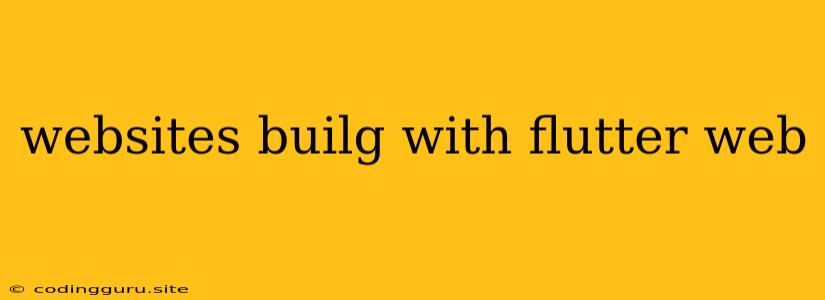Building Websites with Flutter Web: A Comprehensive Guide
Flutter, Google's popular cross-platform framework, has gained immense popularity for its ability to build beautiful and performant mobile applications. But did you know that Flutter can also be used to build websites? Flutter Web empowers developers to leverage the power of Flutter to create interactive, visually appealing, and performant web experiences.
Why Choose Flutter Web for Website Development?
Several compelling reasons make Flutter Web a viable option for building websites:
- Single Codebase, Multiple Platforms: Flutter's core principle of "write once, run anywhere" extends to the web, allowing developers to use the same codebase to build both mobile and web applications. This translates to reduced development time and effort, making it an attractive choice for cross-platform projects.
- Fast Development and Hot Reload: Flutter's hot reload feature significantly accelerates development by instantly reflecting code changes in the running application. This allows developers to iterate quickly and experiment with different ideas without having to wait for lengthy build cycles.
- Rich UI Library and Widgets: Flutter boasts a comprehensive set of widgets, providing developers with a wide array of pre-built components to create visually stunning and highly customizable user interfaces. These widgets can be easily adapted and combined to achieve unique and engaging website designs.
- Excellent Performance: Flutter uses its own rendering engine, Skia, which ensures smooth animations and responsive user interactions. This translates to a faster and more enjoyable user experience on websites built with Flutter Web.
- Growing Community and Support: As Flutter's popularity grows, so does its community of developers. This means access to a wealth of resources, libraries, and support forums, facilitating faster problem-solving and enhancing the overall development experience.
Getting Started with Flutter Web Development
Here's a step-by-step guide to help you get started with Flutter Web development:
- Install Flutter: Download and install the Flutter SDK from the official website.
- Set Up Your Development Environment: Configure your IDE (e.g., Visual Studio Code, Android Studio) to work with Flutter.
- Create a New Flutter Project: Use the
flutter createcommand to create a new Flutter project specifically for the web. - Run Your Flutter Web App: Use the
flutter run -d chromecommand to launch your Flutter Web application in a browser.
Key Concepts and Techniques
- Web-Specific Widgets: While many Flutter widgets are platform-independent, some are specific to web development. Familiarize yourself with widgets like
HtmlElementView,UrlLauncher, andPlatformViewto interact with browser functionality and embed external content. - Routing and Navigation: Implement navigation between different sections of your website using Flutter's routing system. This involves defining routes and using the
Navigatorwidget to transition between pages. - State Management: Employ effective state management techniques like Provider or BLoC to maintain and update the state of your application, ensuring consistency and responsiveness across different screens.
- Performance Optimization: Implement strategies like code optimization, lazy loading, and image optimization to ensure your website performs well on various devices and network conditions.
- Testing and Debugging: Utilize Flutter's testing framework to write unit and integration tests for your codebase. The Flutter DevTools provide debugging tools to identify and resolve issues.
Examples and Use Cases
- Simple Website: Create a basic website with a landing page, about section, and contact form using Flutter Web's core widgets.
- E-commerce Website: Build an online store with product listings, shopping cart functionality, and payment integration using Flutter Web's rich UI library and packages.
- Interactive Portfolio Website: Showcase your work and skills with a dynamic portfolio website featuring animations, interactive elements, and responsive design.
- Data Visualization Dashboard: Use Flutter Web to build interactive dashboards for visualizing data and creating custom charts and graphs.
- Progressive Web Apps (PWAs): Develop PWAs that offer a native app-like experience on the web with features like offline functionality and push notifications.
Conclusion
Flutter Web provides a compelling alternative to traditional web development approaches, offering a single codebase for both mobile and web applications, fast development cycles, a rich UI library, and excellent performance. By leveraging Flutter's capabilities and the growing community support, developers can build engaging and visually appealing websites that deliver exceptional user experiences. Whether you're building a simple portfolio website or a complex web application, Flutter Web offers a powerful and efficient solution.
